Self-Medicating Chimps, Pugilistic Shrimp, and Other Remarkable Animals: An Illustrated Guide
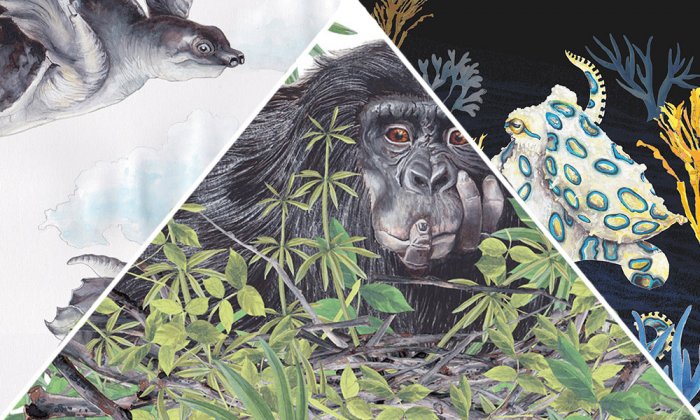
“I feel that there’s nothing more important than to pass on, to my son, the little piece of nothing and everything that I’ve observed — the happiness that comes from watching a dragonfly, spider, frog, lizard, elephant, parrot, mouse, orangutan, or ladybug,” Emmanuelle Pouydebat writes in her new book, “Atlas of Poetic Zoology.” “Each individual creature enriches my own existence boundlessly.”
For Pouydebat, a researcher at the French Museum of Natural History, animals are lyric poets; they discover and shape the world when they sing, dance, explore and reproduce. They are also highly adaptive, having weathered many crises of extinction over millions of years. Her book, a lively and idiosyncratic collection of meditations on 36 extraordinary creatures, invites readers to draw inspiration from their enduring vitality.
In the excerpts featured below, accompanied by striking illustrations by artist Julie Terrazzoni, Pouydebat guides readers through just a fraction of the natural world — one occupied by flightless birds, soaring turtles, self-medicating chimpanzees, pugilistic shrimp, and venomous octopuses.
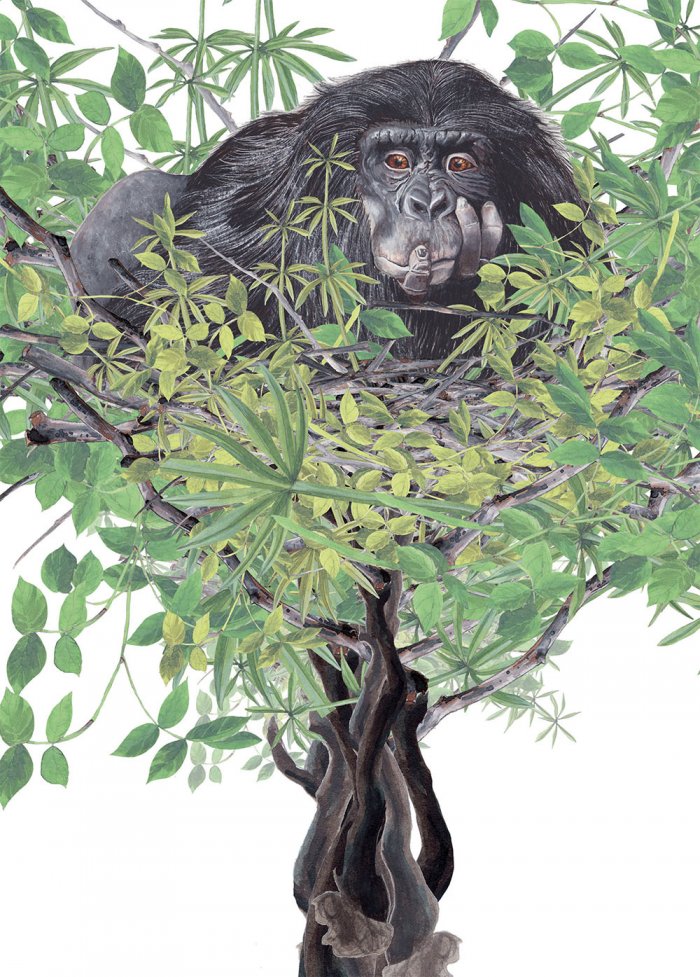
These great apes are primates, like us. Sure, they’re a little hairier, but they’re hominids. Like us, these creatures are amazing. Like us? It’s a risky comparison. In many respects, chimpanzees are more accomplished. One talent they possess would benefit us, too: they know how to take care of themselves. Since the 1970s, researchers have known that chimpanzees — especially those in Tanzania or Uganda — use medicinal plants. They consume fruits with antimicrobial properties; sometimes they combine them with other substances to reduce the toxicity. Other chimpanzees eat flowers with antibiotic properties or leaves with antiparasitic ones, which act as laxatives or even induce uterine contractions. Chimpanzees also tear off bark and lick the resin to kill internal worms; the compounds, tests in vitro have shown, slow the growth of cancerous cells.
Significantly, practices of self-medication vary between chimpanzee populations. When chimpanzees feel sick, they seek out a particular tree and ingest a few leaves. The bitter leaves contain molecules that are quite effective against plasmodium parasites, which cause malaria. But chimpanzees also consume about ten other kinds of plant to combat these organisms. Thus, in contrast to human beings (who use a small number of substances for warding off malaria), chimpanzees diversify their medical arsenal. What’s more, when making their bed for the night, chimpazees in Uganda do so in areas where there are fewer mosquitos. Do they choose plants based on their potential for repelling pests, or is softness — and resulting comfort — decisive? We’ll see.
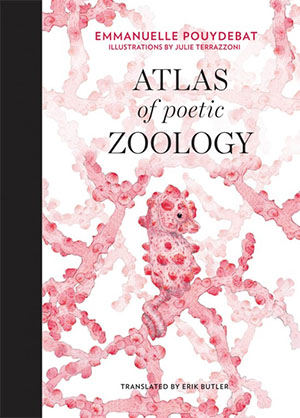
For some time now, chimpanzees’ pharmacopoeia has been the object of study. Indeed, research by Jane Goodall in the 1960s even prompted scientists to reexamine traits thought to be exclusively human. In fact, chimpanzees use an array of tools for different purposes: branches for digging out termites, honey, or marrow; sticks and stones for cracking nuts; and sharpened pieces of wood for spearing galagos (bushbabies); they even make “shoes” to protect their feet when climbing thorny trunks. Using these tools can be complex and require training; some mothers actively show their young the right way. Pedagogy, then, is a practice we share with chimpanzees. Another exciting finding: techniques differ from one population to the next (Uganda, Ivory Coast, Guinea, etc.). Many writers on the subject don’t hesitate to speak of “traditions” and “cultures.” This observation raises another set of questions. Do chimpanzees invent? In Tai National Park, Ivory Coast, generations of chimpanzees were known to use branches to break extremely hard nuts (dura laboriosa). One day, a female member of the group, Eureka, employed a stone for the same purpose and continued to do so in the presence of her companions. And then? Other chimpanzees started doing the same. After a few generations, the entire population had switched tools for cracking nuts, from sticks to stones.
Chimpanzees devise tools, but they’re even better at something else: memorization. The same chimpanzees in Ivory Coast have a geometrical understanding of their territory, which spans twenty-five square kilometers; they move from one spot to another in straight lines, more or less. Even with a limited range of vision — thirty meters, at most — they know where to go to find ripe fruit and avoid danger (including rival chimpanzees!). By remembering topographical features of the landscape and picturing abstract space, they can calculate distance and direction, no matter where they are.
And that’s not the only proof of chimpanzees’ cognitive abilities. In a computer-based test of spatial memory, researchers compared young chimpanzees and university students. The experiment involved clicking numbers one by one, in the right order. At an ulterior stage, the task became more complicated: as soon as subjects clicked the first number, a white square blanked out the other ones; the point was still to press the right series, in order to receive a reward. And the results? The chimpanzees pulled it off 80 percent of the time — that is, twice as often as the students. From an early age, these animals demonstrate highly developed visual memory; it’s almost photographic. This is what enables them to memorize where the best fruit is growing and determine the best path to take. Whenever they don’t prefer to break our cameras, instead — or throw all kinds of stuff at us.
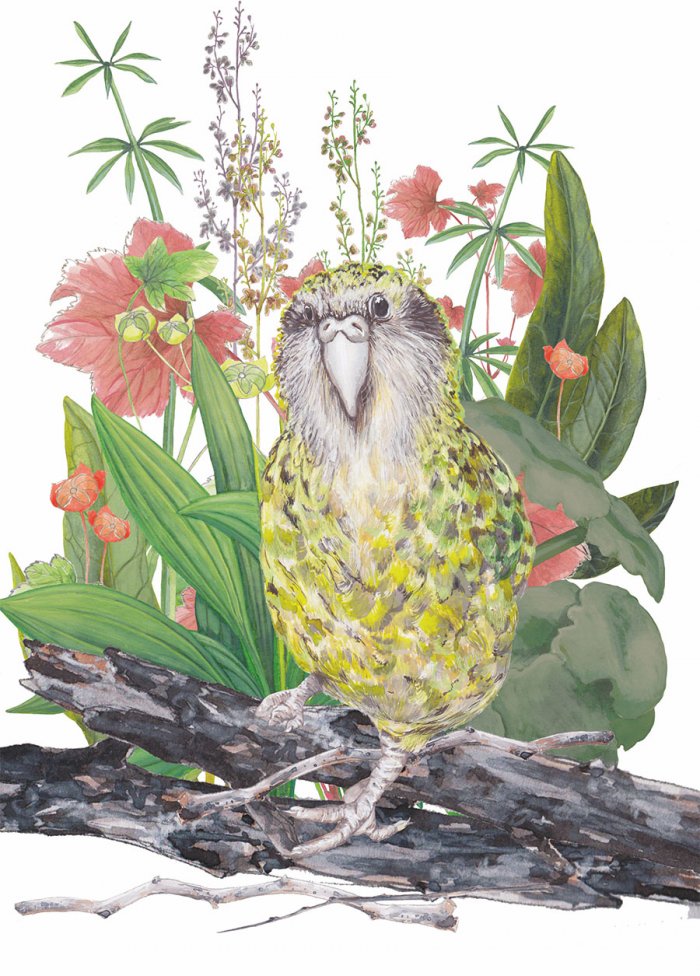
Allow me to introduce another evolutionary and adaptive marvel: the parrot that doesn’t fly. The kakapo — which means “night parrot” in Maori — is the heaviest parrot in the world; it can weigh up to 4 kilos and has short wings and feathers that keep it grounded. But birds haven’t always flown. In all likelihood, feathers didn’t develop in order to enable flight so much as to facilitate individual distinctness and communication. In this regard, the kakapo isn’t an anomaly; it’s a living reminder of extinct birds that never flew in the first place.
The kakapo doesn’t fly; it walks. And thanks to its steely claws, it has no difficulty climbing trees. Yet survival proves difficult, despite a lifespan of ninety years and great skill in the art of seduction. What’s this skill? Males make a real impression by “booming.” Picture the kakapo digging a hole in the ground, inflating a sac in its chest, flapping its wings, and bringing forth inimitable screams — plus a mighty, exploding sound to attract the ladies…. It works! The basin Mr. Kakapo has made amplifies the noise. To this end, he has removed any twigs that might get in the way and carefully chosen a resonant location — for instance, a spot between rock walls or tree trunks. For about eight hours, he makes one “boom” after another night after night, for three or four months straight. In the process, he can lose up to half his body weight. Depending on the winds, Madame Kakapo will hear these booms as far as five kilometers away; wherever she may be, the sound reaches her, for her beau makes sure to boom in every direction. Females journey to meet their suitors who will fight to the death to parade around, click their beaks, and brandish outstretched wings.
In all likelihood, feathers didn’t develop in order to enable flight so much as to facilitate individual distinctness and communication.
Unfortunately, the heartwarming part of the spectacle stops there. Booming attracts predators, too. Plus, predators come looking because of another of Mr. Kakapo’s charms: a moldy smell. This poor parrot is threatened by extinction. Hunted by humans and preyed upon by introduced species (e.g., cats, rats, and dogs) — to say nothing of the effects of deforestation, urbanization, and collecting — the kakapo has all but disappeared.
But sometimes, even human beings prove capable of greatness. In 2012, the 50 remaining kakapos were relocated to three islands without any predators and provided with a constant source of food. It’s no easy matter: the kakapo has a very low reproduction rate, and the sex of chicks depends on what the mother eats. If her diet’s highly caloric, more male offspring are born. If it’s overly rich in proteins, she’ll get full too fast — and fail to eat enough calcium to make shells. At first, the kakapos were given fare that was too rich and plentiful, so too many males were born. The wrong balance means trouble. We need to get the diet right. Plus, a single island can’t host more than a hundred individuals. The situation presents a challenge for birds and humans alike; together, they’re struggling to find solutions and survive.
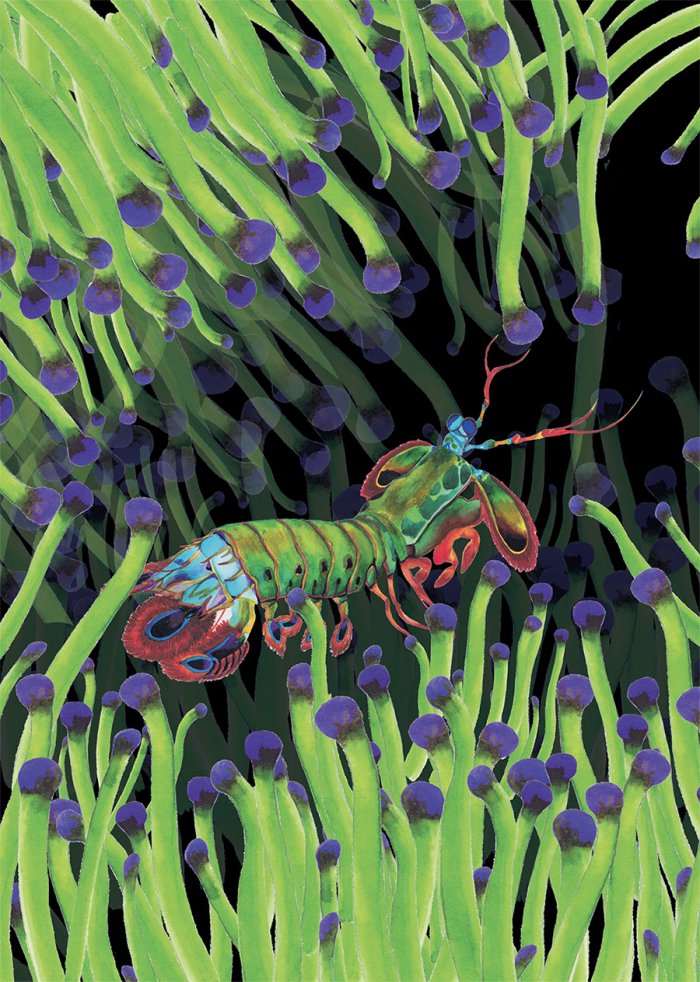
The peacock mantis shrimp is a crustacean inhabiting deep-sea corals, on the rocky or sandy floor, at depths of up to 70 meters. It either dwells in a burrow of its own or settles in one dug by another animal. Days are spent in hiding, but at night it hunts for mollusks, other crustaceans, and fish. The peacock mantis shrimp is a marvel of nature. This magnificent creature is often considered the most aggressive ocean predator; the slightest incursion onto its territory meets with swift reprisal. And to think I thought crayfish were aggressive (having been pinched on more than one occasion). Well, the peacock mantis shrimp is worse! Even divers make sure to avoid it. It’s also known as the “painted mantis shrimp” or “clown mantis shrimp,” because of its bright colors and murderous limbs. The name sounds funny, but it’s no joke.
This animal’s limbs are veritable engines of war — even more fearsome than those of the earthbound mantis. In fact, they’re so light and tough that scientist study them in the hope of creating new protective materials for human use. The appendages serve any number of purposes: by turns, the peacock mantis shrimp uses them to stun or crack open prey, dig burrows, defend itself from predators, and fight against its peers. The firm and round ends, though just a few millimeters in size, permit the diminutive killer to break open shells in a series of blows; then, the victim’s flesh is consumed. The peacock mantis shrimp’s a real boxer. Its hammering is incredibly rapid, precise, and brutal: a speed of 100 kilometers per hour, landing with a force up to 1,501 newtons! The motion is among the fastest in the natural world — as if the little beast were firing bullets with a force of impact thousands of times its body weight. The attack occurs so rapidly, it’s invisible to the human eye — and even more impressive in light of the water resistance. The blows come so hard and fast that even when it misses, the peacock mantis shrimp manages to kill its prey. If we could throw a ball at the same speed, relative to our own weight and size, it would wind up in orbit!
At 100 kilometers per hour, the peacock mantis shrimp’s attack occurs so rapidly, it’s invisible to the human eye — and even more impressive in light of the water resistance.
These arms aren’t the animal’s only resource when defending itself and hunting. The peacock mantis shrimp also has extraordinary vision. Its optical organs comprise thousands of facets and a large fovea — one of the most elaborate visual systems in the animal world. It’s a real marvel of nanotechnology! Each eye functions independently, takes in a full 360-degree range stereoscopically, and detects objects with three different parts of the same organ to assess depth and distance — and aim punches. Their retinas also have the largest number of photoreceptors for color in the animal world: 12 in each eye. Most animals have only two to four photoreceptors; human beings have three (red, blue and green).
This unique feature allows the peacock mantis shrimp to make out colors rapidly, which is especially useful for an animal that’s vibrant itself and lives in variegated coral reefs. It’s a vital resource for fighting, fleeing, communicating, and reproducing. Indeed, the peacock mantis shrimp can even register the polarization of light (i.e., the oscillation direction of electric fields), multispectral images across the electromagnetic spectrum, and ultraviolet rays — a real boon for locating food. Its incredible eyes scan the surroundings to identify different types of coral, follow transparent prey, and detect approaching predators like barracuda. What’s more, they enable the peacock mantis shrimp to tell the tidal phases of the moon, know when females are fertile, and sense a partner’s fluorescence. Without question, this crustacean’s eyes are the most complex in the whole animal world — a sign of the boundless power of evolution.
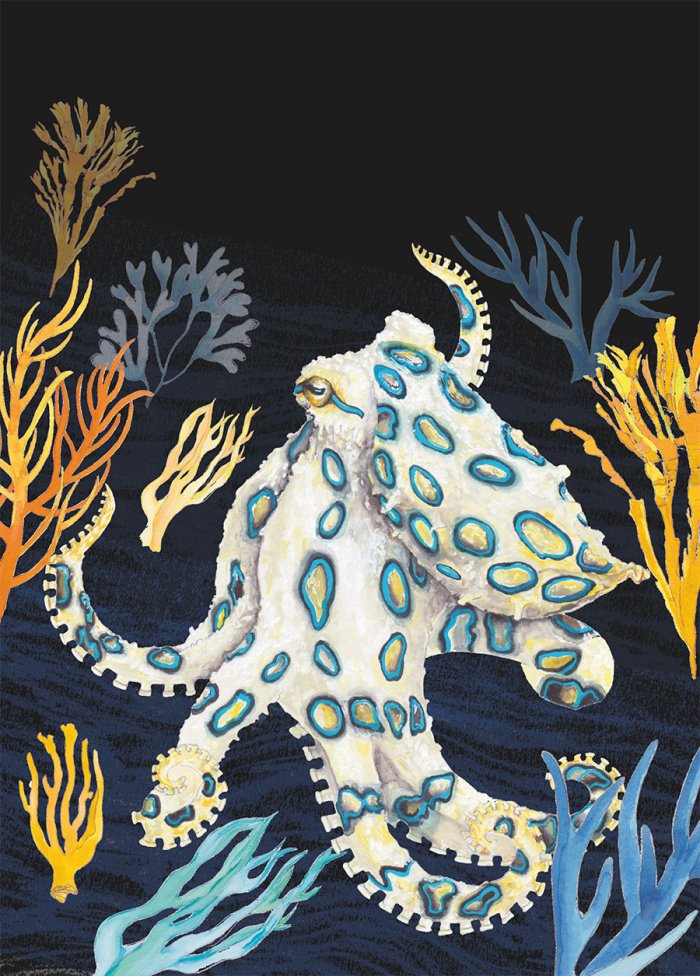
One aquatic animal has no equal when it comes to adapting to the marine environment. The southern blue-ringed octopus is a benthic octopod (in other words, an eight-legged dweller on the seafloor) inhabiting coral reefs, where it feeds on crustaceans, mollusks, and small fish. Its evolution allows it to breathe, move, hunt, and defend itself perfectly in these surroundings.
To breathe in the water, octopuses have gills — like fish — but they’re shaped like feathers and hidden in a muscular cavity whose opening lies behind the tentacles. These creatures suck in water, and the gills capture dissolved oxygen. To diffuse the oxygen, octopuses have three hearts: two that move blood towards the gills, where it loads up on oxygen, as well as a so-called systemic heart that pumps the oxygenated blood to the rest of the body. Finally, a mobile siphon located under the belly expels the water. When this happens quickly, it produces vigorous propulsion, which helps escape predators. Subtler movement takes place through undulating fins, which are assisted by the tentacles; in this way, the octopus crawls on the seabed to catch food, which it shreds with an extremely hard and sharp beak.
That said, the blue-ringed octopus excels most when it comes to self-defense. First of all, millions of pigment cells (“chromatophores”) give it — like many other cephalopods — the power of homochromy, that is, the ability to change color in order to blend in with surroundings. Some octopuses even use shells for cover, or put their tentacles over the gills of predators like sharks in order to stifle the attack and escape! Besides sophisticated camouflage, which sometimes means assuming the appearance of other species (certain cephalopods disguise themselves as hermit crabs!), octopuses use clouds of black ink, which they project while speeding off, in order to gain time to hide. And if that’s not enough, the blue-ringed octopus will bite, injecting a venom in its saliva that’s one of the most powerful in the animal world. The venom contains tetrodotoxin, a neurotoxin that causes death by respiratory failure in a matter of minutes; it’s strong enough to kill a human being. In other words, don’t mess with the blue-ringed octopus.
To survive in an aquatic environment, cephalopods have three hearts, millions of neurons, an unusual sensory system — they gauge water pressure by smell — tactile organs that boast thousands of autonomous suction cups, vision that registers how surfaces refract light, and the ability to live in colonies. Since mothers die shortly after eggs hatch, it might seem that these creatures can’t transmit knowledge and skills they’ve gained. But now we know that cephalopods memorize, learn, invent, and play; indeed, they acquire information about the outside world while still in their eggs!
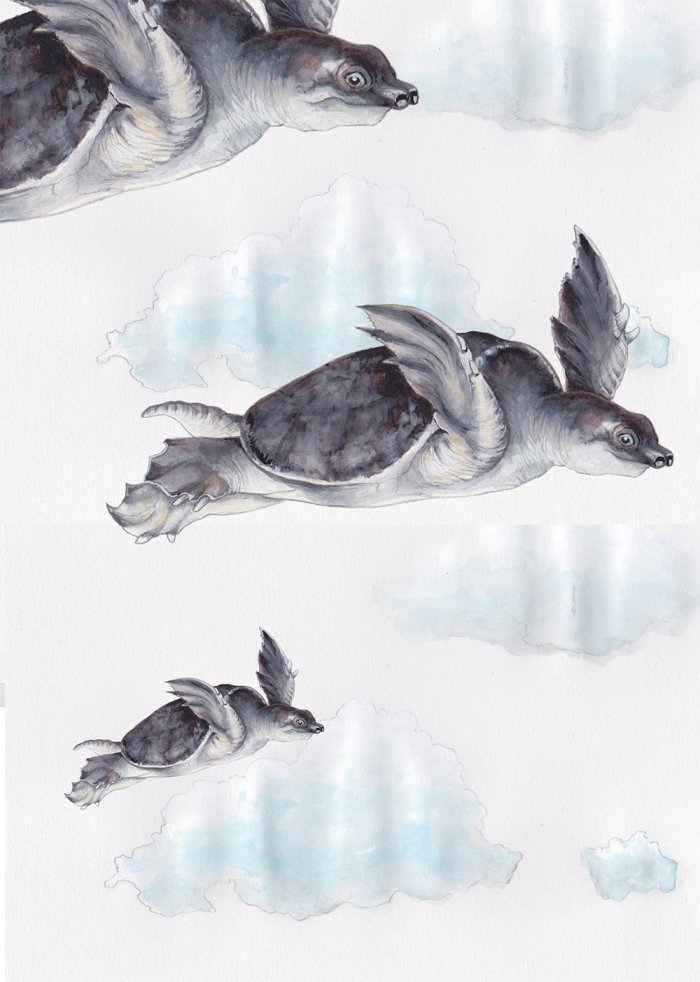
The pig-nosed turtle… what a strange and unique reptile. As it glides along, graceful and calm, it seems to be flying. It’s the biggest freshwater turtle alive, the only survivor of a line that was widespread 40 million years ago. It’s also the only turtle equipped with a prominent snout for flushing out larvae, crustaceans, fish, snails, worms, algae, leaves, or fruit that has fallen into the water. This creature is an opportunistic eater, so it feeds on carrion when necessary.
The pig-nosed turtle takes advantage of the wide range of food available. But eating isn’t enough to ensure survival, which is also a matter of perpetuating the species. Reproduction only occurs every two years. The pig-nosed turtle takes care to optimize the conditions for eggs and hatchlings by means of two remarkable strategies. During the dry season, the female emerges from the water to lay her eggs. In the sand, she digs a nest about 50 centimeters deep and deposits a clutch of about 10 (although it can include up to 40). If the nest is very hot (over 32° C), the young will be female, whereas cooler conditions produce males; if the temperature is somewhere in-between, hatchlings of both sexes are born. Like sea turtles, pig-nosed turtles lay their eggs on the beach. As soon as they hatch, the young of the former are exposed to terrestrial predators; in consequence, very few of them ever reach the water in the first place. But pig-nosed turtles have a way of avoiding this problem: their eggs don’t hatch in the sand. What miracle makes this possible? Dame Nature guides them…. The eggs wait until the water level rises! At the end of the dry season, when water immerses the nest, the young emerge. Just like that, they’re in their element. It also helps that their shells are equipped with “teeth” which make them look like a circular sawblade; this represents another adaptive resource for self-protection, giving the young turtles a chance to grow up.
Even though these turtles hold an important position in the art and legends of native peoples, their habitat is being destroyed by mining and agriculture.
The stakes are vital. These turtles face danger not only from predators such as crocodiles and lizards, but also, more indirectly, from herds of buffaloes (which can trample on nests, eggs, and hatchlings). Plus, invasive species such as the cane toad eat eggs. That said, the biggest threat is surely humankind. Even though these turtles hold an important position in the art and legends of native peoples, their habitat is being destroyed by mining and agriculture. They’re also caught and sold as pets — or consumed for their meat and eggs. In 40 years, the pig-nosed turtle population has declined by more than 50 percent. The scale of destruction is vast: one to two million eggs are collected for international trade every year. If drastic measures aren’t taken to rein in commerce, the animal will soon be threatened by extinction.
Unfortunately, pig-nosed turtles aren’t the exception: two-thirds of all turtles are threatened or endangered, mainly because they’re taken from the wild and sold. Pending better times, this species will grow rarer and rarer. All the same, there is some hope: the pig-nosed turtle is now protected by the Washington Convention, and breeding programs have been started, especially in Australia.
Emmanuelle Pouydebat is a permanent researcher employed by the CNRS (French National Center for Scientific Research), working at the Muséum National d’Histoire Naturelle in Paris. She is the author of “Atlas of Poetic Zoology,” from which this article is excerpted.
Julie Terrazzoni is a French illustrator and set designer.



